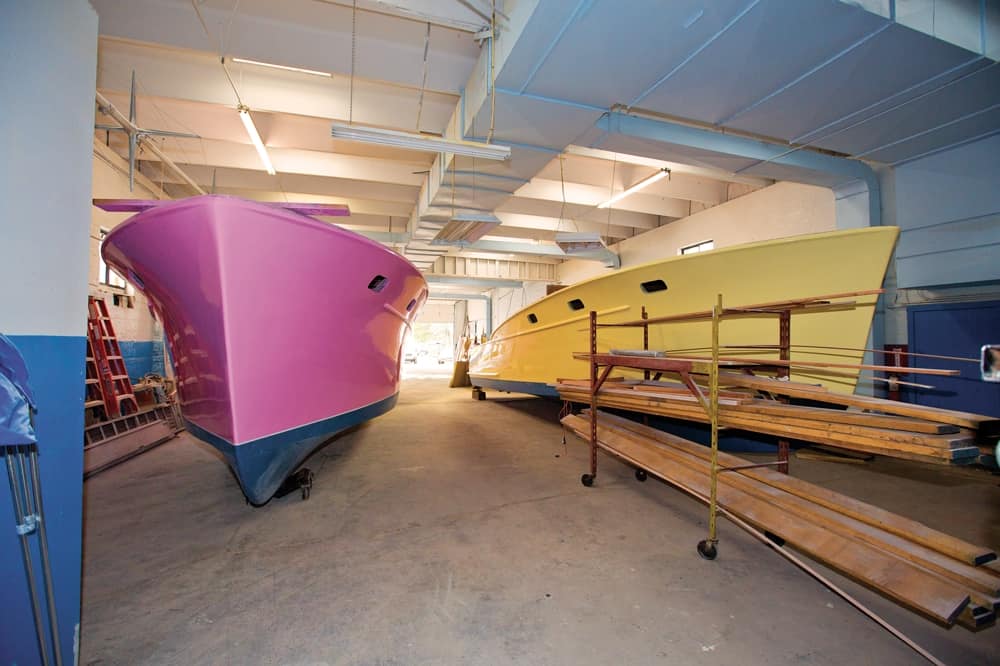by Austin Green
Fast Glass
An old saying goes, “It’s not the camera. It’s the photographer,” which is mostly true. However, modern camera sensors have become very responsive to light, and we are now able to capture the action at high shutter speeds in lower light situations. But, the light must efficiently make it to the sensor, which means—it’s not the camera, it’s the glass. The key is to use “fast” lenses, which have wide apertures that allow more light to pass through to the sensor.
Get a high-quality primary full-frame (FX) lens with a continuous aperture of f2.8 or wider. My Nikon 24–70 f2.8 has been my go-to glass over two camera bodies in virtually any fishing situation. It’s wide enough to get the shot in tight onboard situations, but can reach out and capture the action across the water.
Wide apertures also give you a shallower depth of field (depth of focus), which produces a buttery classic portrait appearance with a blurry background. This brings the attention to your subject (the fish, the angler) while keeping your secret fishing spot under wraps.
Waterproofing
You won’t be taking many photographs with a wet DSLR camera. Get a waterproof case. The Pelican 1550 is the industry standard. For the traveling angler/photographer, the Pelican 1510 has wheels and fits in commercial airliner overhead bins. If you are hiking in and packing out, consider the tough backpack-style Sea to Summit Hydraulic Dry Pack (www.seatosummit.com; available at West Marine and camping stores).
Polarization
Just as polarized glasses are vital to seeing on the water, so too are polarized filters to your camera lenses. Polarization filters cut through UV haze and reduce color distortion in sunlight. They add contrast and clarity to the landscape and your subject matter. They also protect the lens from damage. Choose a circular polarizing filter over a linear version. The circular filter allows you to tune away glare from the surface of the water, the haze in the air of the distant landscape, and the glare on a shiny fish. Get a good multi-coated optical glass one. It doesn’t make sense to place cheap glass in front of a high-quality lens. I recommend filters made by B+W and LEE.
Lighting
Great photos come from great light. The best light occurs at sunrise and as the sun falls to the horizon. So, get up early and return for sunset. As the sun gets higher, the light becomes harsh and flat shadows block out faces hidden beneath the bills of fishing hats. The exceptions are thick overcast days, especially with storm clouds threatening. These shots can be terrific.
Flash
The solution to those high-noon situations is your flash. A flash will bring out the smile on your angler’s face under the hat. It pays to stop your flash power down one or two thirds of a stop and use it to fill in the shaded face of the angler and their fish. This will also cast a “catch light” into the eyes of the fish and the angler to great effect.
A bit of flash as fill light in the morning or evening to balance out the strong orange key light of the sun will improve the result by filling in the shadows
Aperture priority for stealth

When photographing portraits of people and their fish, shallow depth of field can be your best friend. The lower you turn down the f-stop number, the wider the lens aperture becomes and more light gets to the sensor. This also reduces the depth of field in your photograph, which increases the viewer’s attention on the subject. This is how portrait photographers creatively draw attention to their subject instead of whatever might be going on in the background.
A good way to achieve this effect is to set your camera to Auto-ISO (sensor sensitivity) and a low aperture priority such as f2.8. Your camera will automatically select the appropriate ISO and shutter speed to make a balanced exposure. In low light, these settings should be appropriate for the handheld shooting of still subjects, and in bright light, fast moving objects will also be appropriately captured.
Shutter priority for speed
When you need to freeze the rapid action of fish and people, switch to shutter priority to avoid blurring. Handheld shutter speed should be at least 1/60 of a second, and high-speed movement is best captured at 1/500 and up. It’s also best to set your camera’s meter mode to the average frame setting rather than the spot metering mode to ensure a balanced exposure.
Autofocus
If you find that the fish in your shot is blurry, but the trees in the distance tack sharp, you can bet that your camera’s autofocus setting is working against you. The solution is to get to know your autofocus lock button. On most Nikon bodies it’s labeled AE-L/AF-L for autoexposure/autofocus lock. Use it to lock onto your subject regardless of how you finally frame the shot. On a Canon or professional grade Nikon the AF-L button is replaced by a AF-On button. On these cameras, this button, rather than your shutter, controls your autofocus system. Use the AF-On button to lock onto your subject, and press the shutter button simultaneously to capture.
Take advantage of your camera’s full autofocus capabilities. Set your autofocus settings display the highest number of points that your system is capable of. This will enable manual point selection, which will allow you to select the area of the frame that you wish to focus on.
Planning the Shot
A strongly composed, well executed photograph starts with a plan. Fishing adventures can be unpredictable, but a mental shot list will help you and your anglers develop a plan and get the shots you want when an opportunity presents itself. The plan will allow you to select the right lens and camera settings for the event. Will the fish be the primary subject, or will it be the angler and her fish? If you don’t want to reveal the angler, a proper net is going to be a must. If you are promoting careful catch and release practices, keeping a fish in the water can make an epic and more fish-friendly photograph. The important thing is to have a plan and walk through it with your angler If you’re figuring it out after the fish is hooked, you’re too late.

Post Production
The great advantage of digital photography is that you can take hundreds of photographs without having to reload your camera with expensive film and then wait for days to find out what you got. The downside is that you will shoot hundreds of photos and then have to sort, grade, cull, crop, adjust, name and file them. It can ruin your social life.
The way around this is to have an efficient post-production flow. I’ll cut to the chase by recommending Adobe’s Lightroom, an inexpensive program that allows you to download, catalog, edit and process your images from one dashboard. You can add your copyright and contact information in batches while tagging your images with location information. Lightroom also handles basic editing needs—exposure, color, saturation adjustments and cropping. It’s about $150 from most office and photo outlets. The program is also available through Adobe’s cloud subscription plan at $10 a month.
File Format
There are two file format options these days, JPEG and RAW. JPEGs are compressed files. RAW files are not, and therefore have much more data to draw from in the editing process.
Professionals shoot in RAW to have the greatest flexibility in adjusting and correcting their images. You should too. While you are in your camera’s shooting menu, set the color profile to Adobe RGB, an uncompressed profile. I also recommend setting your exposure compensation to underexpose your shots by ½- to a full-stop when shooting RAW files. Uncompressed images will have a lot of data buried in the shadows, which can be pulled out if necessary in post-production.
Fish Handling
Let’s keep in mind that we are dealing with living creatures. A great photographer shoots with accountability and respect for the fish, the people and the resource. When possible, keep your fish in the water by photographing it in the net, or during the release. If you must remove the fish from the water, a good careful-catch and release method is to hold your own breath for the duration of time it takes to gather up the fish, set up the shot, fire off a few frames and return the fish to the water. Then you will understand how little time you and your fish have to work with.
Share
Have fun with it and be sure to share your material. Great photos provide inspiration to others to enjoy and care about the outdoors. Enter your photographs in competitions, start a personal blog, self-publish a book, or submit your work to publications. There is no substitute for hands-on experience in the process of learning the photography. Get out there, work with your camera, make mistakes, improve your craft, and capture exceptional moments!
Please reach out to me with any follow-up questions you might have. I would be pleased to help you. Contact me and view my portfolio by visiting www.austingreenphotography.com or by emailing me at austingreenphoto@gmail.com.



